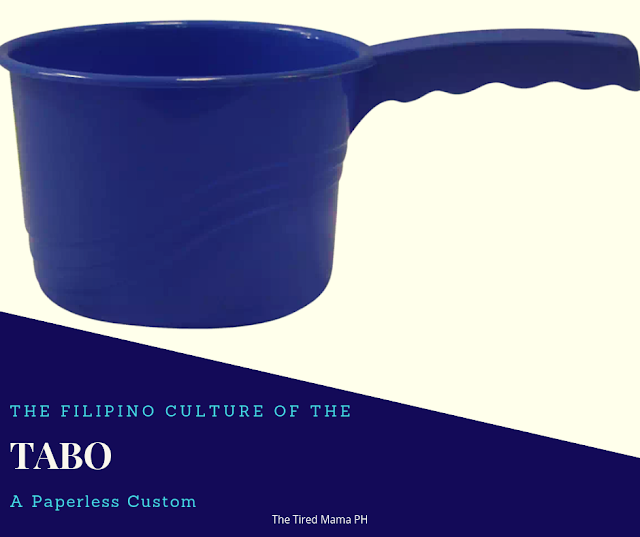The Filipino Culture of the Tabo: A Paperless Custom
My parents recently went to the US to visit my baby brother who recently bought a house. Of course, my mom, like every mother, did some nitpicking on the cleanliness of the house ( I was told my brother had housemates at the time), their bachelor lifestyle (my brother is single and ready to mingle), and how healthy they ate (my mom complained about all the take-out trash she saw). But, according to my brother, she really went ballistic over one tiny item that can be found in every household in the Philippines, can be bought for under a dollar here in the Philippines, and can't be found in any Bed, Bath and Beyond in the great United States... the TABO (pronounced tah-boh).
My mother complained that she should have brought some from the Philippines for my brother to keep so, she would have one to use when she comes and visits. I guess she took it for granted thinking that my brother had one. Plus, we used to live in the United States, so I know she knows how difficult it is to find one. She advised me to get a couple for my brother to bring home with him when he comes and visits the Philippines in 2020.
What is the TABO?
Description
First of all, let me describe what a tabo is and what it is used for, that is, most of the time.
 |
| A bucket full of water with a green tabo. |
Generally speaking, not all households in the Philippines have a shower, a bath tub, or a bidet shower (that sprinkler hose thing near the toilet used for anal cleansing). For some households which do not have running water (tap water via faucet) and view water as a scarce resource, the house members have to collect water from a source within their community or pump it out from a deep well to carry home in buckets or pails (timba). This process of collecting water and carrying it home is called "igib".
There are 2 types of toilets in the Philippines: 1. De buhos and 2. With Flush. The "de buhos" toilet requires users to douse or pour water in the toilet after each use with enough force for it to flush. And because water can be scarce at times, so comes the saying, "If it's yellow, let it mellow. If it's brown, flush it down."
Toilet paper, on the other hand, may be viewed by most Filipinos as an unnecessary expense, thus, you may not always find toilet paper in the bathrooms of Filipino homes. Filipinos believe in washing the anal region thoroughly with soap and water after defecating. The use of just toilet paper for wiping the anus isn't enough. Some, maybe even most Filipinos, make it a ritual to defecate before taking a bath since they have to wash themselves clean anyway.
As for malls and rest stops, these establishments have started providing toilet paper in restrooms for its patrons for free but, don't expect that there will be toilet paper or tissue all the time. This is why the "pocket tissue" is an indispensible item in a Filipina's purse.
If you enter a stereotypical household in the Philippines, what you'll find in the bathroom is the toilet and a faucet with a bucket and a tabo underneath that one faucet. Sometimes, you'll find a tabo at the kitchen sink or at the laundry area. I guess, now, you have a picture of what a tabo is. Filipinos use it to scoop water, be it for flushing the toilet, cleansing, bathing, laundry, washing dishes, or at certain times, cooking. It may be used to scoop other liquids as well, but mainly, it is used for water.
Brief History of the Tabo
During pre-colonial Philipines, the humble tabo was made up of recycled coconut shells and bamboo and was considered as an all-purpose household object. Before entering a home, a tabo and a terracotta jar (palayok) could be found at the entrance. Guests would then wash their hands and feet before entering their host's home. At the kitchen, one would find the storage of drinking water in another terracotta jar with a tabo and another jar and tabo for washing dishes.
 |
| A palayok and a tabo. |
During Spanish colonization in the Philippines, the people made use of the 'sartin'. When the Americans came, the modern tabo, made of plastic, was introduced and up to this day, the Filipinos still make use of this simple tool although, mostly, the tabo's use is now restricted to the bathroom unless needed elsewhere around the house.
If you type in tabo and ask for the translation on Google Search, you'll get the word "mug" since some are modelled after a mug. If you scroll down for other translations, you'll find that it translates to either "pitcher" or "dipper". Mug (the thing we use to drink coffee with and not mug in "mug shot") in Filipino is "tasa" (although I believe "tasa" means cup) while pitcher is "pitsel". As for the word "dipper", I think this is the closest term that can be used as a direct translation of "tabo" since, it is dipped in a bucket or pail full water. Manila Bulletin, in an article "The Novelties of a Filipino Home", seems to agree, translating tabo to dipper and defining it as a small pail with a handle which Filipinos use to bathe, wash themselves after using the toilet, water the plants and to even wash their cars. According to UP Chancellor Dr. Michael Tan in an article he wrote for The Philippine Daily Inquirer, even "dipper" is not sufficient a term to translate the tabo. He says "tubby" is a more appropriate term when translating tabo into English.
The Filipino Culture of the Tabo
You may think that only middle-class or poor Filipinos use the tabo. Even some of the rich and wealthy Filipinos use the tabo. I've been to wealthy people's homes before (some even of Foreigners) and was surprised to find a tabo. Basically, almost every Filipino household uses the tabo and even if they don't have one at home, they will at least come in contact with it at a restroom that doesn't have running water or if the restroom's toilet's flush doesn't work. It's a hassle but, really, what can you do?
And when balikbayans (Filipinos living abroad returning to their homeland) come home, they buy some to bring back with them to their country of origin (my aunts do this). I have a friend who loves to travel and he has a small tabo which he brings with him. He says that his "travel-size tabo" is sort of like his lucky charm. He can't imagine ever parting with it.
For Foreigners who can not fanthom using the tabo, you can read this post by a Canadian who wrote about using the tabo and even complimenting the Filipinos for conserving water as well as going "paperless".
The Importance of the Tabo
For Foreigners who can not fanthom using the tabo, you can read this post by a Canadian who wrote about using the tabo and even complimenting the Filipinos for conserving water as well as going "paperless".
The tabo is an indispensible tool for Filipino everyday living, here or abroad. Since we are bound for a paperless society, the Filipino culture of the tabo will continue. Gone is the need to stack rolls and rolls of toilet paper. All one would need is the handy tabo and your business inside the bathroom will be done.
As for cleaning, why use paper towels when a wet rag and soapy water in a tabo is all you need to clean a certain area. For watering your plants, you can also use the tabo. During drought, I use the water I have used to do the laundry to water my plants and water my small lawn. I use my trusty tabo and give each flower pot a drink water. Then, I throw the rest on the grass. I have recycled the water and my plants have some water to thrive against the glaring sun. I have seen some use the tabo when washing their cars. Water according to them has to be conserved and using a hose to rinse off their car doesn't exactly do that plus, they have noticed that they also get a higher water bill when they use their hose.
The bidet shower and the automatic shower toilet in more contemporary homes is expensive to install and may not really allow homeowners to conserve water unless you have an entirely "green" home that recycles used water. An automatic shower toilet is said to cost around $1200-5000 USD and may use up to 6 liters of water to completely wash the nether regions. A bidet shower or bidet toilet seat may be much affordable to purchase, but for the typical Filipino household, why bother? The humble tabo is good enough. It's the Filipinos' instrument in helping conserve water and trees... our way of continuing to go "green" for a sustainable living.
Need to come back to this post? Pin it.
Related links:
"Tabo" Culture by Michael L. Tan, Inquirer.net
Related posts:
As for cleaning, why use paper towels when a wet rag and soapy water in a tabo is all you need to clean a certain area. For watering your plants, you can also use the tabo. During drought, I use the water I have used to do the laundry to water my plants and water my small lawn. I use my trusty tabo and give each flower pot a drink water. Then, I throw the rest on the grass. I have recycled the water and my plants have some water to thrive against the glaring sun. I have seen some use the tabo when washing their cars. Water according to them has to be conserved and using a hose to rinse off their car doesn't exactly do that plus, they have noticed that they also get a higher water bill when they use their hose.
 |
| A bidet shower attached to a toilet. |
The bidet shower and the automatic shower toilet in more contemporary homes is expensive to install and may not really allow homeowners to conserve water unless you have an entirely "green" home that recycles used water. An automatic shower toilet is said to cost around $1200-5000 USD and may use up to 6 liters of water to completely wash the nether regions. A bidet shower or bidet toilet seat may be much affordable to purchase, but for the typical Filipino household, why bother? The humble tabo is good enough. It's the Filipinos' instrument in helping conserve water and trees... our way of continuing to go "green" for a sustainable living.
Need to come back to this post? Pin it.
Related links:
"Tabo" Culture by Michael L. Tan, Inquirer.net
Related posts:
 |
| Undas: A Philippine Tradition Honoring the Dead |
 |
| 30 Pinoy Slang Words |







Comments
Post a Comment
Thanks for taking the time to read my post. If you have any questions or feedback, feel free to leave me a message here in the comments section. You may also contact me through my email address sheilamarie070677@gmail.com for more pressing matters. Thank you!